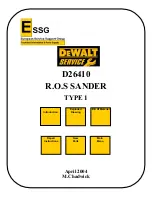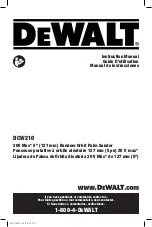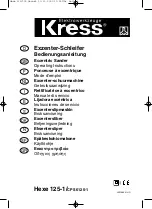
5
Remove PSA Sanding Disc Before
Storage
Do not store the sander with the sanding disc in-
stalled. Heat generated from sanding causes the
pressure sensitive adhesive to flow and form a tight
bond between the backing pad and sanding disc.
Removing the sanding disc soon after you have fin
-
ished a sanding operation avoids letting the adhesive
set up. If the sanding disc is left on the backing pad
for an extended period of time after use, the adhesive
will set up and cause the sanding disc to become
difficult to remove.
It may also tear when removing. When this situation
occurs, it becomes difficult to clean the backing pad
for the next sanding disc.
NOTE
: If you forget to remove the sanding disc after
a sanding operation, sand for a few minutes to soften
the adhesive backing before attempting to remove
sanding disc.
WARNING
Collected sanding dust from sand-
ing surface coatings such as
polyurethanes, linseed oil, etc. can self-ignite in
the sander dust box or elsewhere and cause fire.
To reduce the risk of fire always empty the dust
box frequently (10-15 minutes) while sanding and
never store or leave a sander without totally
emptying its dust box. Also follow the recom
-
mendations of the coatings manufacturers.
Dust Box with Filter
The dust box provides a dust collection and air filtra
-
tion system for the sander. Sanding dust is drawn up
through the holes of the sanding pad and collected
in the dust box during sanding. To use the dust box:
1. Unplug the sander.
2.
To
insert
, slide the dust box chute into the sander's
dust port. Ensure the dust box vents are facing
up and push sander and dust box together firmly.
3.
To
remove
, grasp the sander and dust box firmly
and pull apart.
4.
To
empty
, using the tabs, pull off the dust box
lid. Empty dust from the dust box and tap filter
clean. Do not clean filter with water or compressed
air. Replace filter when necessary (Cat. No.
43-31-0105).
For more efficient operation, empty the dust box
when it is no more than half full. This will permit the
air to flow through the box better. Always empty and
clean the dust box thoroughly upon completion of
a sanding operation and before storing the sander.
Universal Hose Adapter
Use the universal hose adapter to attach the sander
to a vacuum hose.
1. Unplug the sander.
2. Remove the dust box from the sander.
3.
To insert, slide the adapter into the sander's dust
port. Push sander and adapter together firmly.
Connect the vacuum hose to the adapter, twisting
together to secure.
4.
To
remove
, disconnect the vacuum hose from
the adapter. Then, grasp the sander and adapter
firmly and pull apart.
WARNING
When sander is not connected to
vacuum, always reinstall dust box
assembly back onto sander. Failure to do so
could cause sanding dust or foreign objects to
be thrown into your face or eyes which could
result in possible serious injury.
OPERATION
WARNING
To reduce the risk of injury, always
unplug tool before attaching or
removing accessories or making adjustments.
Use only specifically recommended accessories.
Others may be hazardous.
To reduce the risk of injury, always wear proper
eye protection marked to comply with ANSI Z87.1.
When working in dusty situations, wear appro-
priate respiratory protection or use an OSHA
compliant dust extraction solution.
Starting and Stopping the Tool
To
start
the sander, press the
ON
(I) button.
To
stop
sander, press the
OFF
(O) button.
Speed Dial
The speed dial allows the sander to operate at vari-
able speeds - from low speed (1) to high speed (6).
1.
To increase sanding disc speed, turn the dial to
a higher setting.
2.
To decrease sanding disc speed, turn the dial to
a lower setting.
WARNING
Finish sanding can produce clouds
of fine dust that could ignite in the
presence of sparks or open flame. Always wear
a suitable dust mask or respirator and use your
sander in a well-ventilated area.
To reduce the risk of injury, inspect for and
remove all raised nails and fasteners from work-
piece before sanding. Striking a fastener while
sanding could cause loss of control.
General Sanding with Random Orbit
Sanders
When using random orbit sanders there are a few
things to keep in mind:
•Unlike most sanders, random orbit sanders should
be placed on the workpiece BEFORE the tool is
started. If the sander is started before it is placed on
the workpiece, the free floating pad may be spinning
at a speed that can cause scratches when it is finally
placed on workpiece.
•Unlike most sanders, random orbit sanders can be
moved across the workpiece in any direction (in the
case of wood, regardless of the direction of the grain).
•Varying pressure applied to the sander will affect its
rotating speed. A light pressure is recommended for
fine work, moderate pressure for rough work. Exces
-
sive pressure does not allow the pad to rotate enough.
•Keep sanding pad flat on the workpiece.Tipping the
sander or using the edges of the pad may produce
an uneven finish, and reduce pad life.
•Keep sander moving in broad even strokes across
the workpiece. Sanding in one spot too long can
cause gouging and uneven results.
•Check the workpiece frequently, random orbit sanders
work more aggressively than simple orbital sanders.






































